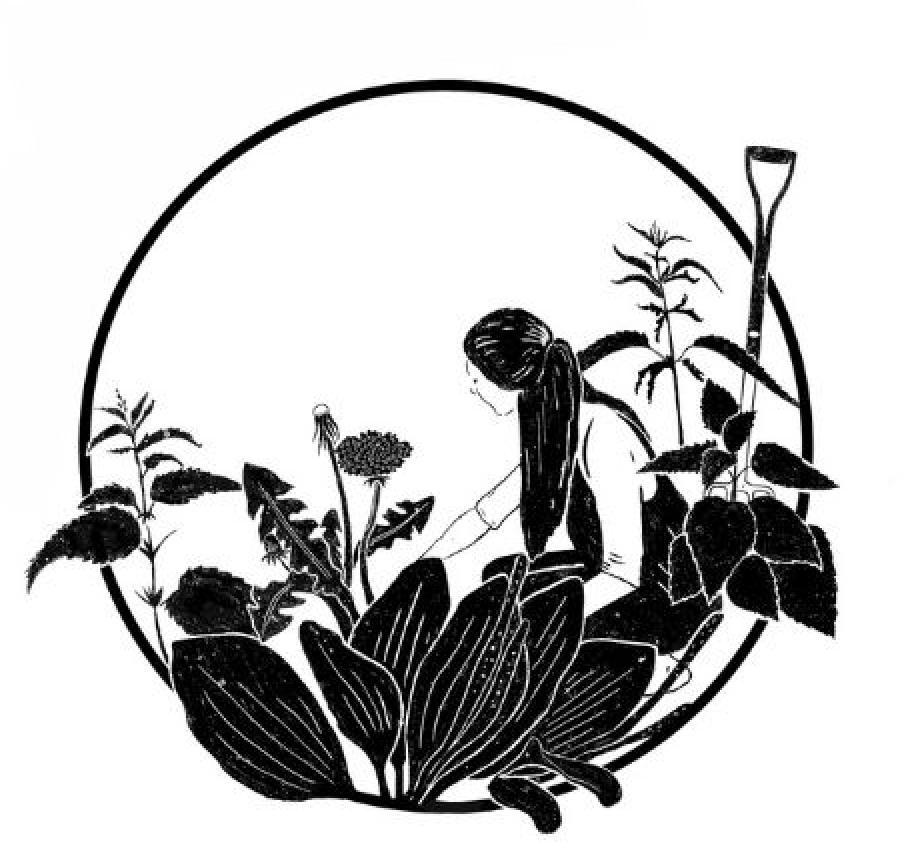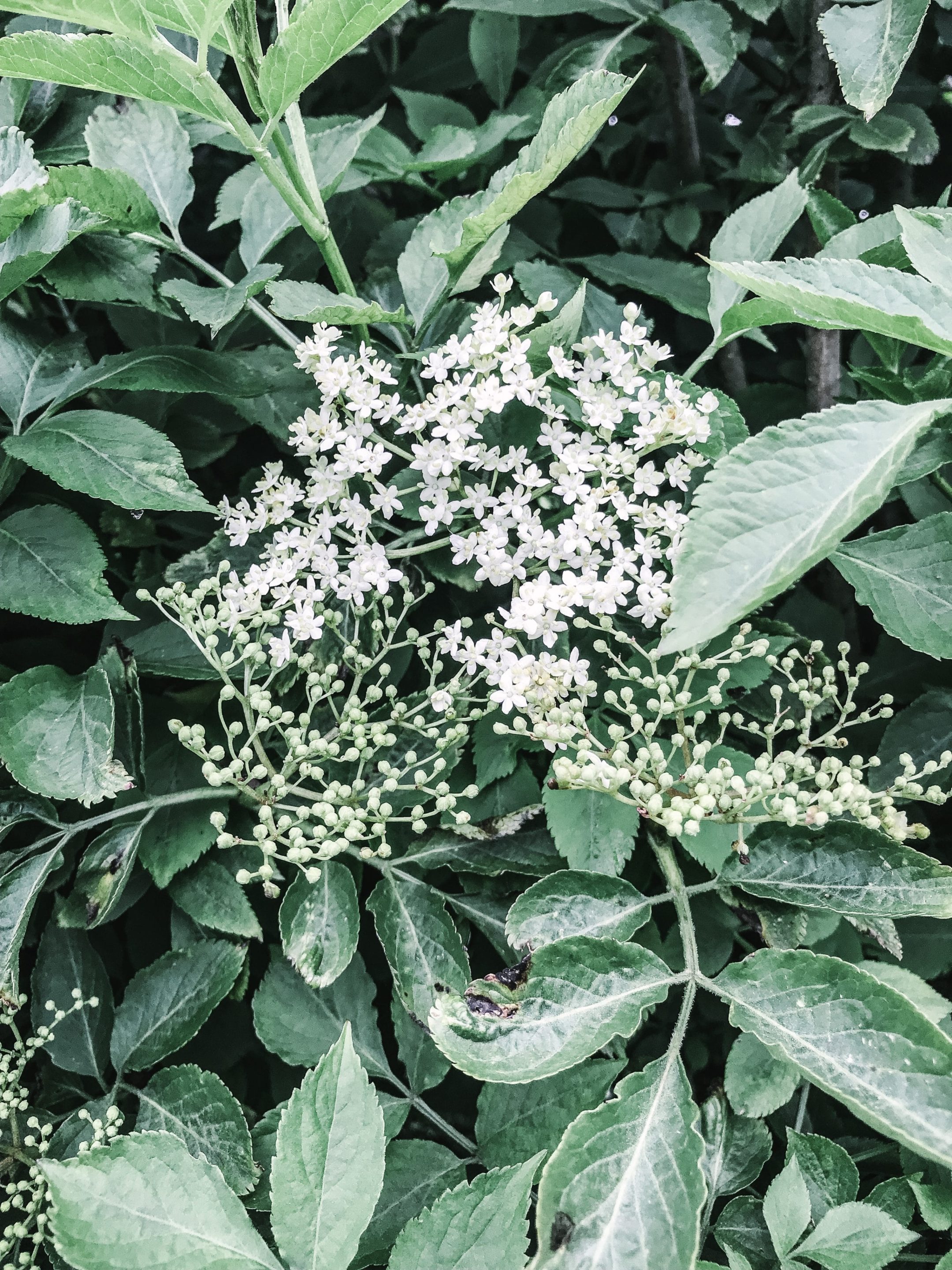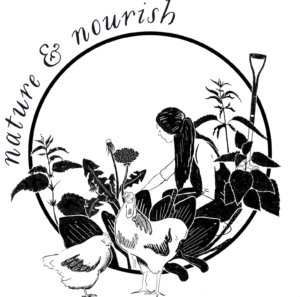In this post I will be Sharing why I love this plant, my favourite recipes, ways to identify as well as herbal remedies.
This herbal spotlight is a regular series on this blog and my podcast, with last month bringing a focus on another beautiful wild edible nettle! So be sure to check that out it you haven’t already.
——
Elder shrubs have always been a part of my childhood. Their unmistakeable scent, not altogether very pleasant in my opinion is also a sort of vague memory of my annual summer holidays, dusty lanes and pony rides! I can still recall how those little creamy flowers would brush by me on walks leaving powdery pollen on my sleeves. Later on in late summer and autumn the trees would weigh down under these umbrellas of deeply purple round berries. I have to admit I did eat these directly off the tree although I now know that’s quite silly as raw elderberries are actually toxic along with it’s leaves! But at the time I couldn’t resist the tempting beauty of those berries!
Nowadays I’m both older and wiser and enjoy elderberries cooked into luscious syrups or sauces where they are perfectly edible and in fact bursting with health benefits. And of course like a lot of people, I consume elderflower profusely in cordials as well as teas when Im feeling under the weather. I even incorporate elderflower into skincare too thanks to it’s anti-inflammatory benefits.
Elder has a long history of being used in a variety of ways. The romans supposedly used the berries it as a hair dye, while it’s immune boosting properties have made them a popular herbal remedy for flus and colds. The berries were extensively used in wine making, although less popular now adays- interesting fact, there used to be orchards of elder especially for this use! Flowers are commonly used in cordial making and an old traditional gypsey remedy for colds includes elderflower in the recipe.
Identifying Elderflower and Elderberry
Sambucus Nigra otherwise known as the Elder is grows in abundance in both rural and urban settings. It prefers partial shade and rich, moist ground and is often found growing along roads and the edges of fields.
Elder grows up to 30 feet tall, a deciduous shrub, it’s leaves are pinnate (which simply means the leaf’s stem has a line of smaller leaves on each side) there can be 5-7 oval shaped smaller leaves or leaflets per leaf. These are toothed at the edges.
Flowers are either pale creamy white or pink depending on the variety and clustered together in a large flat umbrella shape. They have a very unique scent.
Berries arrive at the end of summer and hark the start of the autumn and back to school. They are small, round and dark purple when ripe and hang off the tree in clusters.
Like most plants, elder also has a few look-a-likes, mainly the Wayfaring Tree and the Rowan but Elder is distinctive with its scent, leaf shape and berry colour. It is also worth noting that there is a very pretty pink variety of elder called Black Lace which makes a pink hued cordial! This is what we have growing in our garden and it’s just lovely!
Of course it’s important to get a good guide book and make sure you are picking the right thing. I really recommend Richard Mabey’s Food for Free book as a good all round foraging book.
Harvesting Elderflowers and Elderberries
When it comes to picking elderflower you will want to pluck the entire umbel of blossoms not the flowers individually, and carefully remove any insects. Pick the flowers on a dry day, preferably at midday and be careful when handling to ensure as much of the fragrant pollen remains on the flower. Avoid washing the flowers for the same reason and remove any brown coloured flowers. Remember to leave some flowers on the tree in order to have berries later on and also for the benefit of hungry insects!
Berries are harvested in the same way-cut the entire umbrella of berries at the stem. Berries can be washed and make sure you toss any green ones. A nice little trick To quickly remove the berries from the stem is to use a fork! This works so well and is a bit of a life saver when you have pans of syrup to make!
Health Benefits and Herbalist uses of Elderflowers & Elderberries
Elderberry and flower have plenty of health benefits due to their vitamin content-mainly C and A, as well as their antiviral, sweat inducing qualities and anti-allergy effects. Elderflower is also a lovely addition into infused oils for the skin due to it’s anti-inflammatory qualities.
The flowers are often used in a traditional cold and flu tea that originated from an old gyspy remedy. The elderflowers having anti-inflammatory and anti viral effects as well as aiding breaking a fever are well placed in this tea. They are also popular in a hay-fever or anti-anti-allergy infusion for their anti-anti-inflammatory and soothing abilities.
Recipe: Natural Cold and Flu Tea
To make a Cold and Flu Tea simply combine equal parts of dried elderflower with dried yarrow and dried peppermint and use 1 tsp per cup of hot water. Let infuse for at least 20 minutes before straining. For an elderflower hay fever tea check out my nettle spotlight episode.
Elderberries have even more of an antiviral effect and as a result are a popular remedy for colds and flus in the form of yummy syrups. They also are known to boast the immune system so make a really great preventative as well.
Recipe: Elderberry Syrup
Making a syrup is pretty easy. The most important thing to remember is that you will need to combine equal amounts of honey or sugar to the infused liquid. To make a simple elderberry syrup start off by washing 400g of berries and removing the stems and discarding. Place the berries in a pan and add 500ml of boiling water. Bring back to the boil and then simmer until soft. Let cool then strain. Retuen the liquid to the pan and simmer again until it’s reduced by about half. Measure out the liquid and add equal amounts of raw honey. Stir well to combine and then pour into a bottle. Keep refrigerated and use within 3 months.
Using Elderflowers and berries in the Kitchen
Elder provides us with lots of lovely recipes for the kitchen. From cordials to fritters, the flowers are a delicious early summer treat and one not to be missed. There is really nothing quite like the taste of a cold glass of elderflower cordial on a warm day. They can also be dipped into batter and fried or for a slightly healthier version the flowers mixed through sweet pancakes. The flowers can also be combined with gooseberries and early summer berries in jam, infused into teas or vinegars, and also make a very delicately flavoured icecream! This is something we will be making in the farm cafe this year and I cant wait to feast on elderflower ice-cream!
Apart from the flowers, elder also has the wonderful berries to utilise. They can be made into sauces including the traditional Pontack sauce, chutneys, jams, vinegar, wine and as a raisin substitute in cakes and breads.
Recipe: Elderflower Cordial
A cordial recipe is something we should all have in our repertoire and this one is really easy and can be adapted to other flowers such as meadowsweet too.
Take 1.2 litres of water and bring to the boil. Reduce the heat to medium and Add 1 kg of caster sugar and stir well until completely dissolved. Bring back to the boil and then simmer until the water and sugar becomes syrup like. Remove from the heat.
To make the cordial take one large colander of elderflower blossoms and remove any stems. Add the flowers, 30g citric acid and three thinly sliced unwaxed lemons to the syrupy liquid in the pan. Stir well and place on the lid. Leave for 24-48 hours.
Strain through a muslin cloth and pour into bottles. The cordial will last for a few months but personally I like to freeze it so that I have that fresh summery taste in mid winter too!
Recipe: Pontack Sauce
An interesting recipe for elderberries is this pontack sauce. Quite an old recipe, it could be described as an elderberry ketchup, rich and spiced and great paired with game, stews and sauces. This recipe I sourced from Richard Mabey’s food from free and Im excited to give this a go once elderberry season is in full flow!
500ml vinegar
500ml elderberries-stalks remocved
1tsp salt
40 peppercorns
12 cloves
1 blade of mace
1 onion chopped finely
1/2 tsp ground ginger
Place the berries in a casserole dish with he vinegar and place in a low oven overnight. Strain through a sieve, mashing the berries as you go to get all the juice. Put the juice in a pan on the stove with the rest of the ingredients and bring to a gentle boil. Boil for about 20 minutes. Strain again and pour into bottles. This can be aged for a couple of weeks, months or even years! Apparently the flavour will improve with age!



